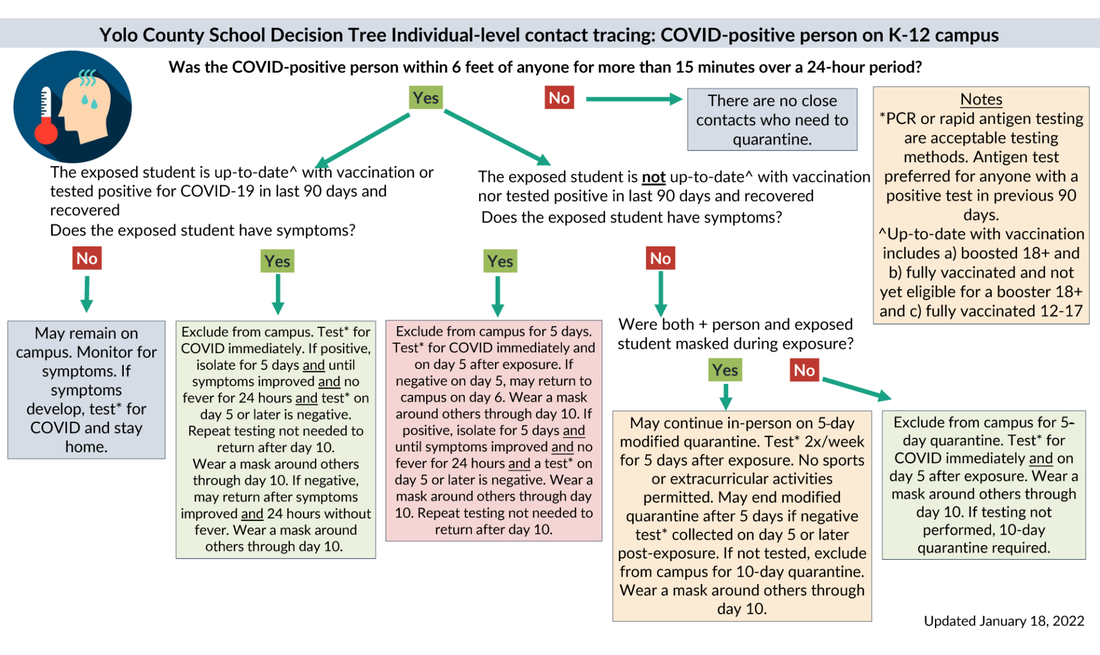UPDATED Yolo County Decision Tree for COVID-Positive Cases on a K-12 Campus

The Yolo County Decision Tree for COVID-Positive Cases on a K-12 Campus was updated on August 31, 2021, to reflect the latest changes to California Department of Public Health (CDPH) quarantine guidance. Read the Yolo County press release outlining the changes.
The updated version of the decision tree is available on the Yolo County Roadmap to Recovery webpage and on the Washington Unified COVID-19 Resources webpage.
The Yolo County Decision Tree for COVID-Positive Cases on a K-12 Campus was updated on August 31, 2021, to reflect the latest changes to California Department of Public Health (CDPH) quarantine guidance. Read the Yolo County press release outlining the changes.
The updated version of the decision tree is available on the Yolo County Roadmap to Recovery webpage and on the Washington Unified COVID-19 Resources webpage.
Yolo County Decision Tree Frequently Asked Questions
How do we count the days since exposure to determine when quarantine can end?
COVID 19-vaccines are effective. They decrease the chances of getting and spreading the virus that causes COVID-19. COVID-19 vaccines help keep you from getting seriously ill, even if you do get COVID-19. Getting vaccinated yourself may also protect people around you, particularly people at increased risk for severe illness from COVID-19.
The day of exposure is Day 0. If planning to use the 7-day shortened quarantine with a negative test, the following timeline applies:
Day 0: Exposure (e.g., Sept 1)
Day 1: quarantine (e.g., Sept 2)
Day 2: quarantine (e.g., Sept 3)
Day 3: quarantine (e.g., Sept 4)
Day 4: quarantine (e.g., Sept 5)
Day 5: quarantine (e.g., Sept 6
Day 6: quarantine and collect test (e.g., Sept 7)
Day 7: final day of quarantine (e.g., Sept 8)
Day 8: return to normal activity if test from Day 6 is negative (e.g., Sept 9)
What is the difference between isolation and quarantine?
Isolation applies to persons confirmed or suspected to be infected with COVID-19. Persons with a positive test and persons with symptoms consistent with COVID-19 are required to isolate. While in isolation, an individual should remain in a single location, typically their home, and not come into contact with others (except to receive health care). Quarantine applies to persons exposed to someone with COVID-19 who have no symptoms and have not tested positive. Because they have been exposed, they are at risk of developing COVID-19, so public health officials ask them to quarantine apart from others during the incubation period of the virus. While in quarantine, an individual should remain in a single location, typically their home, and not come into contact with others (except to receive health care). Because the duration of isolation and quarantine may be different, it is important to understand the distinction, even though both involve staying out of contact with other people.
What is modified quarantine?
Modified quarantine is available only to K-12 students. A student who was in close contact with a case during school while both the case and student were wearing masks is allowed to stay in school for in-person learning if they have no symptoms, get tested twice a week, and continue to wear a mask. A student on modified quarantine is not allowed to participate in extracurricular activities or instructional activities where they remove their mask, like band. A student on modified quarantine is allowed to eat and drink on campus. A student on modified quarantine should quarantine at home when not at school. If a student on modified quarantine fails to complete the required testing, their quarantine will convert to standard, at-home quarantine.
Should someone who has just one symptom on the list of COVID-19 symptoms get tested for COVID-19?
Yes! While the list of potential COVID symptoms is long, many cases have only a single symptom, especially initially. Do not assume that any symptom is “just a cold” or “just allergies.” Any symptom on the list of COVID symptoms should be considered COVID until proven otherwise. Any one of the following symptoms is consistent with COVID-19 and should prompt testing: fever, chills, cough, shortness of breath, sore throat, runny or stuffy nose, loss of taste or smell, muscle or body aches, nausea, vomiting, and diarrhea.
